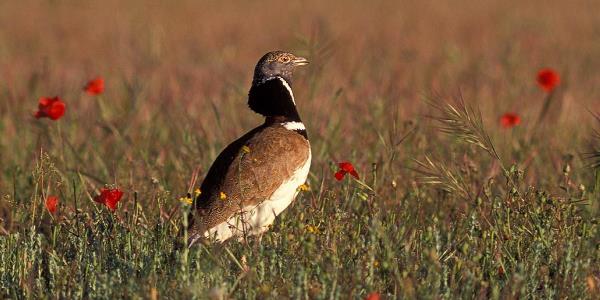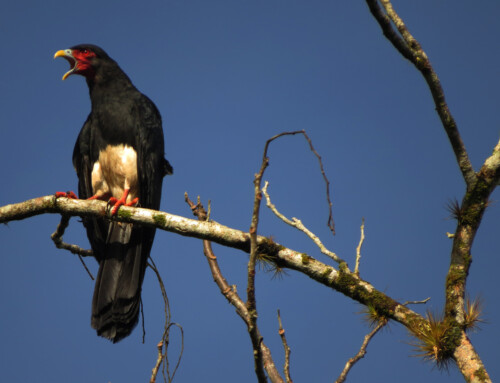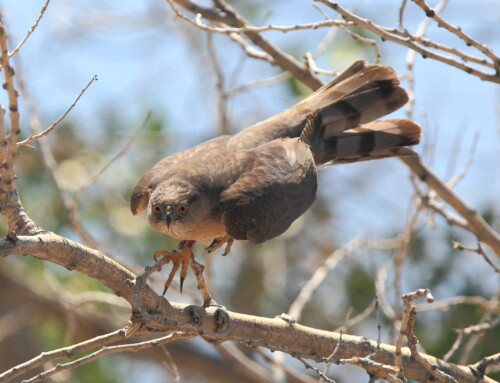Does traffic noise in a road-surrounded area near a large city influence the spatial distribution of Little Bustards?
LINKED PAPER
Traffic noise pollution does not influence habitat selection in the endangered Little Bustard. Martínez-Marivela, I., Morales, M.B., Iglesias-Merchán, C., Delgado, M.P., Tarjuelo, R. & Traba, J. 2018. Ardeola. DOI: 10.13157/arla.65.2.2018.ra5. VIEW
Anthropogenic noise has been shown to alter the distribution, behaviour and physiology of wildlife species (Fahrig & Rytwinski, 2009; Goodwin & Shriver, 2011), and particularly of birds, due to their general dependence on acoustic communication when breeding (Summers et al., 2011). We evaluated the effect of traffic noise on habitat selection by Little Bustard, Tetrax tetrax, males in a cereal farmland area near the city of Madrid traversed by roads linking this site to the Spanish capital.
The Little Bustard is a threatened steppe bird, rapidly declining in large sectors of its geographical range (García de la Morena et al. 2017), that inhabits dry cereal farmland and grasslands in Western Europe (see for example Morales et al. 2005). Little Bustard males are polygynous and defend loosely aggregated territories that females visit for mating: an exploded lek mating system (Jiguet et al. 2000). Males perform different types of advertising displays including a snort call whose main function seems territorial, although it may also be involved in female attraction (Jiguet & Bretagnolle 2014, Morales et al. 2014). Therefore, traffic noise and other forms of acoustic pollution might reasonably be expected to interfere with mating and thus breeding success. The purpose of this study was to evaluate whether the traffic noise associated with the roads crossing our area influenced the spatial distribution of Little Bustard male territories, as well as to determine the significance of that influence relative to other variables known to be important in the species’ habitat selection.
Traffic noise was estimated across the study area by means of a spatial model elaborated according to the calculation method recommended by the 2002/49 European Directive on Environmental Noise Assessment and Management National (French Calculation Method ‘NMpb-Routes-2008’, Dutilleux et al., 2010). Such a model allowed the sound pressure affecting Little Bustard male territories to be estimated (Fig. 1).

When traffic noise pressure was used along with habitat characteristics and distance to nearest neighbour (a proxy of conspecific interaction between males) to explain the spatial distribution of territorial males (individually identified on the basis of phenotypic traits, Arroyo & Bretagnolle 1999), its importance turned out to be negligible (Fig. 2). Instead, the distance to the nearest neighbour had the strongest influence, as found in previous studies (Tarjuelo et al. 2013, Devoucoux et al. 2018). The closest male distance was followed in importance by habitat variables that have also found to be significant in other studies of male Little Bustard habitat selection in central Spain (Morales et al. 2005, Tarjuelo et al. 2014).

We therefore conclude that traffic noise does not seem to influence use of space by Little Bustards in the study area, which suggests that noisy but otherwise adequate areas could act as ecological traps if noise levels interfere in anyway with male mating success and fitness. We consider this to be a significant consideration for the conservation of Little Bustards and other farmland species in Europe, where roads are spread across the countryside as a consequence of urban encroachment (Benítez-López et al. 2010), and the effect of their associated noise pollution on use of space by bird species has scarcely been studied. A more detailed study on the response of acoustic traits of Little Bustard male calls to traffic noise would help to answer this question.
References
Arroyo, B. & Bretagnolle, V. 1999. Field identification of individual Little Bustard Tetrax tetrax males using plumage patterns. Ardeola 46: 53–60. VIEW
Benítez-López, A., Alkemade, R., Verweij, P.A. 2010. The impact of roads and other infrastructure on mammal and bird populations: a meta-analysis. Biological Conservation 143: 1307–1316. VIEW
Devoucoux, p., Besnard, A. & Bretagnolle, V. 2018. Sex-dependent habitat selection in a high-density Little Bustard Tetrax tetrax population in southern France, and the implications for conservation. IBIS DOI: 10.1111/ibi.12606. VIEW
Dutilleux, G, Defrance, J., Ecotière, D. & Le Duc, E. 2010. NMPB-Routes-2008: The revision of the French method for road traffic noise prediction. Acta Acustica united with Acustica 96: 452–462. VIEW
Fahrig, L. & Rytwinski, T. 2009. Effects of roads on animal abundance : an empirical review and synthesis. Ecology and Society 14: 21. VIEW
García de la Morena, E.L., Bota, G., Mañosa, S., Morales, M.B. 2017. II Censo Nacional de sisón común: el dramático declive del bastión europeo de la especie. In SEO/BirdLife. Programas de seguimiento y grupos de trabajo de SEO/Birdlife 2016, pp 4-11. SEO/Birdlife, Madrid. VIEW
Goodwin, S.E. & Shriver, W.G. 2011. Effects of traffic noise on occupancy patterns of forest birds. Conservation Biology 25: 406–411. VIEW
Jiguet, F., Arroyo, B. & Bretagnolle, V. 2000. Lek mating systems: a case study in the Little Bustard. Behavioural Processes 51: 63–82. VIEW
Jiguet, F., Bretagnolle, V. 2014. Sexy males and choosy females on exploded leks: Correlates of male attractiveness in the Little Bustard. Behavioural Processes 103: 246-255. VIEW
Morales, M.B., García, J.T. & Arroyo, B. 2005. Can landscape composition changes predict spatial and annual variation of Little Bustard male abundance? Animal Conservation 8: 167–174. VIEW
Morales, M.B., Casas, F., García de la Morena, E.L., Ponjoan, A., Calabuig, G., Martínez-Padilla, J., García, J.T., Mañosa, S., Viñuela, J. & Bota, G. 2014. Density dependence and habitat quality modulate the intensity of display territory defence in an exploded lekking species. Behavioral Ecology and Sociobiology 68: 1493–1504. VIEW
Summers, P.D., Cunnington, G.M. & Fahrig, L. 2011. Are the negative effects of roads on breeding birds caused by traffic noise? Journal of Applied Ecology 48: 1527–1534. VIEW
Tarjuelo, R. Delgado, M.P., Bota, G., Morales, M.B., Traba, J., Ponjoan, A., Hervás, I., Mañosa, S. 2013. Not only habitat but also sex: Factors affecting spatial distribution of Little Bustard Tetrax tetrax families. Acta Ornithologica 48: 119-128. VIEW
Tarjuelo, R. Morales, M.B., Traba, J. & Delgado, M.P. 2014. Are species coexistence areas a good option for conservation management? Applications from fine scale modelling in two steppe birds. PLoS One 9: e87847. VIEW
Image credit
Featured image: Male Little Bustard, Tetrax tetrax, in a fallow field © Tatavasco images
Blog posts express the views of the individual author(s) and not those of the BOU.
If you want to write about your research in #theBOUblog, then please see here.






